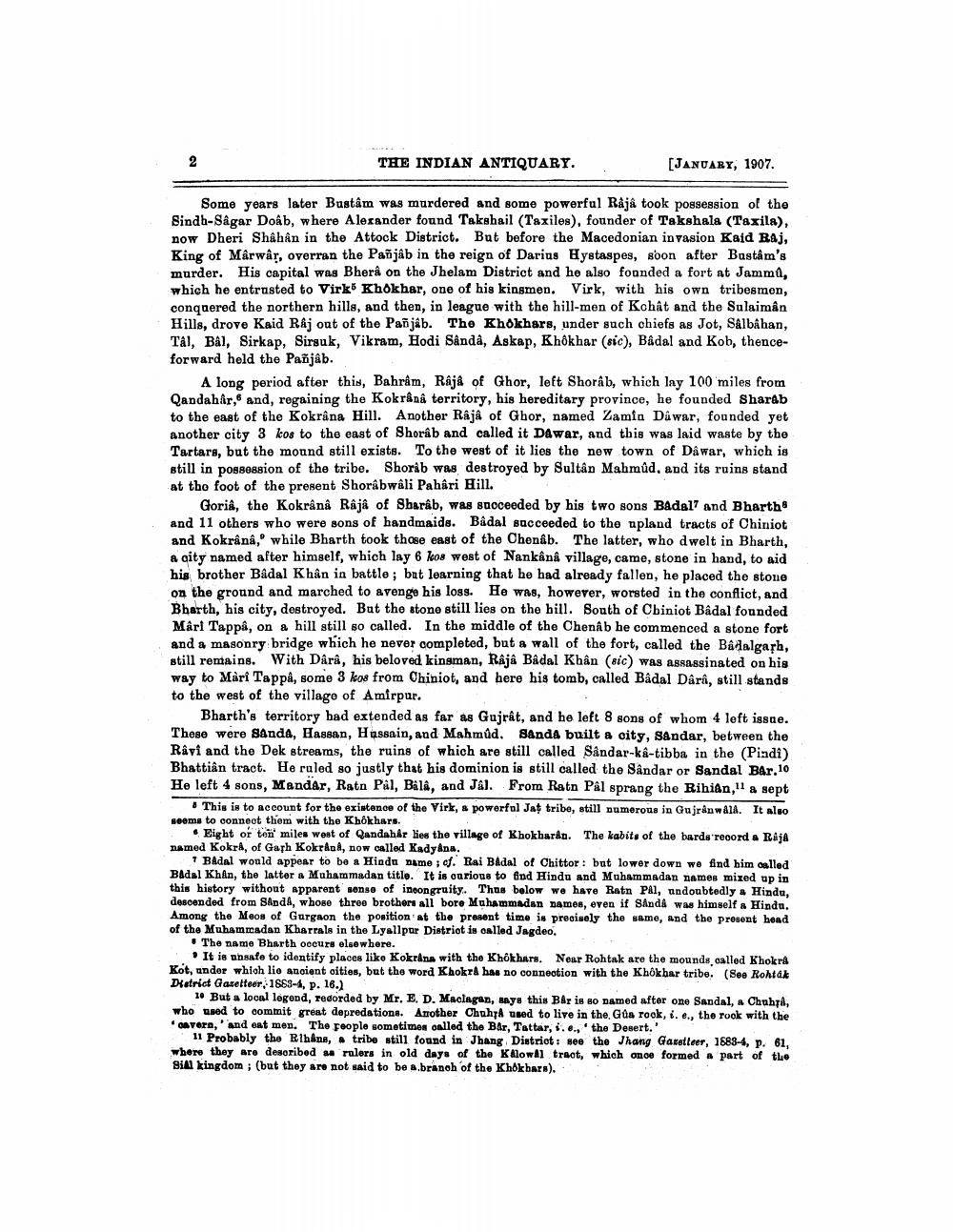Book Title: Indian Antiquary Vol 36 Author(s): Richard Carnac Temple Publisher: Swati Publications View full book textPage 6
________________ THE INDIAN ANTIQUARY. [JANUARY, 1907. Some years later Bustam was murdered and some powerful Râjâ took possession of the Sindh-Sagar Doab, where Alexander found Takshail (Taxiles), founder of Takshala (Taxila), now Dheri Shahin in the Attock District. But before the Macedonian invasion Kaid Raj, King of Mârwâr, overran the Pañjab in the reign of Darius Hystaspes, soon after Bastâm's murder. His capital was Bher on the Jhelam District and he also founded a fort at Jamma, which he entrusted to Virk Khokhar, one of his kingmen. Virk, with his own tribesmen, conquered the northern hills, and then, in league with the hill-men of Kchat and the Sulaiman Hills, drove Kaid Raj out of the Pañjab. The Khokhars, under such chiefs as Jot, Salbêhan, TAI, Bal, Sirkap, Sirguk, Vikram, Hodi Sándâ, Askap, Khokhar (sic), Badal and Kob, thenceforward held the Pañjab. A long period after this, Bahram, Raja of Ghor, left Shoráb, which lay 100 miles from Qandahar, and, regaining the Kokrânâ territory, his hereditary province, he founded Sharab to the east of the Kokrâna Hill. Another Raja of Ghor, named Zamia Da war, founded yet another city 3 kos to the east of Shorâb and called it Dawar, and this was laid waste by the Tartars, but the mound still exists. To the west of it lies the new town of Dâ war, which is still in possession of the tribe. Shoråb was destroyed by Sultan Mahmûd, and its ruins stand at tho foot of the present Shorábwâli Pahâri Hill. Gloria, the Kokrana Raja of Sharab, was sooceeded by his two sons Badal' and Bharth and 11 others who were sons of handmaids. Badal succeeded to the upland tracts of Chiniot and Kokrâná," while Bharth took those east of the Chenab. The latter, who dwelt in Bharth, A city named after himself, which lay 6 kos west of Nankina village, came, stone in hand, to aid his brother Badal Khan in battle; but learning that he had already fallen, he placed the stono on the ground and marched to avenge his loss. He was, however, worsted in the conflict, and Bharth, his city, destroyed. But the stone still lies on the hill. South of Obiniot Bâdal founded Märt Tappa, on a hill still so called. In the middle of the Chenab he commenced a stone fort and a masonry bridge which he never completed, but a wall of the fort, called the Badalgarh, still remains. With Dårå, his beloved kinsman, Raja Badal Khân (sic) was assassinated on his way to Mari Tappå, some 3 kos from Chiniot, and here his tomb, called Badal Dârî, still stands to the west of the village of Amirpur. Bharth's territory bad extended as far as Gajrât, and he left 8 sons of whom 4 left issue. These were sanda, Hassan, Hassain, and Mahmûd. SandA built a city, sandar, between the Ravi and the Dek streams, the ruins of which are still called Sandar-ka-tibba in the (Piadi) Bhattiân tract. He ruled so justly that his dominion is still called the Sândar or Sandal Bar. 10 He left 4 sons, Mandar, Ratn Pál, Bålê, and Jal. From Ratn Pal sprang the Rihiên," & sept This is to account for the existence of the Virk, a powerful Jat tribe, still numerous in Gujranwall. It also sooms to conneot them with the Khokhars. Eight or ton miles west of Qandahar kes the village of Khokharan. The kabits of the bards record a RAJA named Kokra, of Gash Kokrina, now called Kadyana. BAdal would appear to be a Hindu name ; cf. Rai Badal of Chittor : but lower down we find him oalled Badal Khan, the latter a Muhammadan titlo. It is curious to end Hindu and Muhammadan names mixed up in this history without apparent sonse of incongruity. Thas below we have Ratn Pål, undoubtedly a Hindu, all bore Mohammadan names, even if Sanda was himself a Hindu. Among the Meos of Gurgaon the position at the present time is precisely the same, and the present bead of the Muhammadan Kharrals in the Lyallpur District is called Jagdeo. The name Bharth occurs elsewhere. It is unsafe to identify places like Kokrana with the Khokhara. Near Rohtak are the mounds called Khokra Kót, ander which lio ancient oition, but the word Khokrá has no connection with the Khokhar tribe. (See Rohtak Diatrict Gazetteer, 1883-4, p. 16.) 1. But a local legend, redorded by Mr. E. D. Maclagan, says this Bar is so named after one Sandal, a Chuha, who used to commit great depredatione. Another Choh used to live in the, Gus rook, 1. e., the rook with the onvern,' and eat men. The people sometimes called the Bar, Tattar, ...,' the Desert.' Probably the Elhana, # tribe still found in Jhang District : see the Jhang Gaxetleer, 1883-4, p. 61, where they are desoribed m rulers in old days of the KalowAl tract, which once formed a part of the 911 kingdom; (but they are not said to be a branch of the Khok barn).Page Navigation
1 ... 4 5 6 7 8 9 10 11 12 13 14 15 16 17 18 19 20 21 22 23 24 25 26 27 28 29 30 31 32 33 34 35 36 37 38 39 40 41 42 43 44 45 46 47 48 49 50 51 52 53 54 55 56 57 58 59 60 61 62 ... 430
